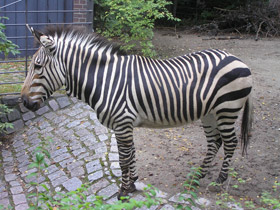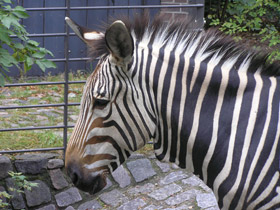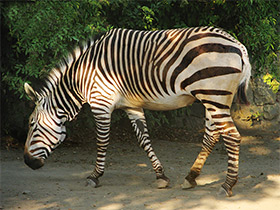Hartmann's mountain zebra (Equus zebra hartmannae)
Hartmann's mountain zebra (Equus zebra hartmannae) is a subspecies of the mountain zebra found in far south-western Angola and western Namibia, easily distinguished from other similar zebra species by its dewlap as well as the lack of stripes on its belly.
Taxonomy
It has been argued that Hartmann's mountain zebra should be considered a separate species from the Cape mountain zebra, but this is not supported by genetic evidence (see Mountain zebra#Taxonomy). Consequently, it is no longer considered a separate species in Mammal Species of the World. 2005.
A Hartmann's mountain zebra with a Barbary sheep behind it, in captivity at Ueno Zoo, Japan.
Description and distribution
Equus zebra hartmannae is a subspecies of the mountain zebra belonging to the family Equidae.
It has been argued that Hartmann's mountain zebra should be considered a distinct species from the Cape mountain zebra, but this is not supported by genetic evidence. Consequently, it is considered a subspecies in Mammal Species of the World.
Equus zebra hartmannae is much smaller than other zebra subspecies (125 cm tall) and has long ears and a special skin fold under the throat (subthorax). They are found in the mountainous plateaus of south-west Africa and in Namibia and southern Angola, at altitudes up to 2000m. They live in small groups of one male, about 5 females and their cubs.
Habitat and behaviour
They are agile climbers and can live in arid conditions and rugged mountainous areas.
Hartmann's mountain zebras prefer to live in small groups, ranging from as few as 3 individuals to as many as 12. Herds may be breeding herds, with a stallion and many mares, or bachelor herds, consisting mainly of young males. Young males bred as foals in breeding herds are usually culled at 24 months, after which they can become stallions in their own breeding herds within 5 years. When two breeding herds come into contact, each stallion faces the other in an elaborate ritual of posturing.
Hartmann's mountain zebra has been described as an ecosystem engineer, for as it bathes in dust it creates a persistent depression known as a rolling pit. Even after the zebra leaves a rolling pit, it will usually remain visible for many years. These rolling pits appear to provide a favourable microsite for native vegetation, which ultimately leads to denser growth throughout the pit.
Conservation status
Equus zebra hartmannae is the rarest of the zebras and, unfortunately, its numbers continue to decline.



















































